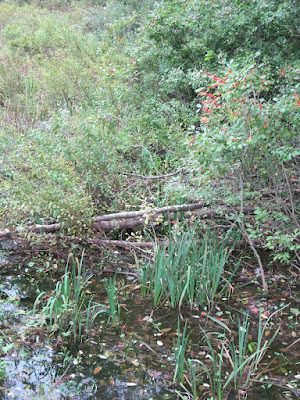This pictured bog is part of the 130 acre farm that included our 36 acres. We do not own this land where the bog is located but are on good terms with its current owner. Just this week the Town Highway crew replaced an old rotted sluice pipe with a new and larger model. Sometimes road crews are made uneasy by water close to their road and this spirit might have been intensified by the recent Gilbertsville flood where four huge beaver dams burst in response to local heavy rainfall inflicting heavy damage. In this instance the new pipe was placed so that the bog could maintain its past water level. This bog is not fed by any stream as its only source of water is rainfall that makes its way down a small wooded slope in a subdued manner.
My first experience with this bog happened more than thirty years ago when I served as adult supervision for an outing of seventh grade students. The owner of this land then, Ginny, felt that her daughter's classmates might enjoy a visit here. We were accompanied by a retired science teacher with a long association with the great outdoors. At that time the bog was more open with a natural walking path along the edge of the woods opposite the road. The teacher guide shared the names of a large number of native plants that grew here and all of us had a pleasant dry outdoor experience.

This picture is similar to the one above it but this view shows more water. This farm was established more than 200 years ago and it is likely that gravel fill was dumped where the road is now lessening the severity of the natural dip in the road. The last glacier dropped a great deal of sand below the present surface of the ground allowing water to simply disappear into the ground. The muck that formed here as plant material rotted slowed water seepage so this spot is never totally dry. We have absolutely no desire to discover the depth of the muck. Blue Flag is claiming more of this ground every year. I would like to move a few but have not sought permission from the owners since I do not want to risk a closeup muck experience.
Becky captured this image of a Wild Cranberry bush that is doing extremely well in this location.
A number of years ago I was allowed to accompany the members of Becky's herb group to an outing at the Bolster Hill Bog. Our leader was a professor at a local community college. This bog met all of the requirements necessary to be called a bog, No stream delivered water there. Rainfall was the only source of the impounded water. The plants that grew there were not in contact with firm ground but grew as part of floating masses. We were advised to simply remain calm if we fell in as a rescue would be attempted. We were to take some comfort from the fact that if we slipped under and died our bodies would not rot because of the acidity of the water and lack of wildlife in the water.
The bog here is much smaller than the Bolster Hill bog and not likely as deep. It deserves another visit from us. Come Spring we will seek permission to venture around the dry side of this well hidden treasure.




1 comment:
Fascinating. Wetlands are such important, underappreciated, and disappearing ecosystems.
Post a Comment